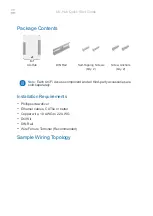
Additional information
17 of 31
Revision 4.0
2021-10-11
Recommendations for board assembly of Infineon transistor outline
type packages
Mounting of through-hole devices
Figure 9
Lead bending for mounting hole offset compensation (left) and heatsink to lead
arrangement for compensation of relative movement (right).
When bending the leads it is very important to comply with the following guidelines:
Clamping
Clamping, bending and cutting need to be done sequentially in that order as shown in
a subsequent process is not allowed to be initiated before the preceding process is finished.
A properly designed clamping tool supports a reproducible bending shape. In general, the larger the clamp
area the more reliable the quality of the lead forms.
The clamp shall be designed to avoid excessive mechanical forces such as pulling and shearing between the
leads and the package body. Between the point of bending and the package edge, tensile stress during the
bending process needs to be relieved. Avoid slippage due to weak clamping, as well as weakening of the
lead due to overly strong clamping.
Under no circumstances must the plastic body be held or restricted while lead forming as this has the
potential to mechanically damage the package-particularly at the metal-to plastic interface. In case of a
package containing an isolated backside (e.g. FullPAK packages, TO247 Advanced Isolation) it has to be
taken into consideration not to damage the isolation in any of the tools used for pre-mounting processes.
In case the package has an increased lead width next to the package body (cut dam bar), the bending
distance X needs to be higher than the length of area with the increased lead width L1 as shown in
. If the there is no increased lead with by a cut dam bar the minimum distance between the package body
and the first bend should be 2.5 mm as shown in
Bending the leads parallel to the lead plane or immediately adjacent to the package as shown in
not allowed.
Radius
The general rule of thumb is to create a bending radius R that is one to two times the material thickness T as
shown in
. It is recommended that the bend radius should never be less than the thickness of the
lead material.
The minimum bend radius R needs to be 0.5 mm.
Force
The maximum force applied to the leads between the clamp and the point where the bending force is
applied should not exceed a certain limit. This maximum force is mainly dependent on the cross-sectional
area of the lead. A typical maximum force is 20 N.















































